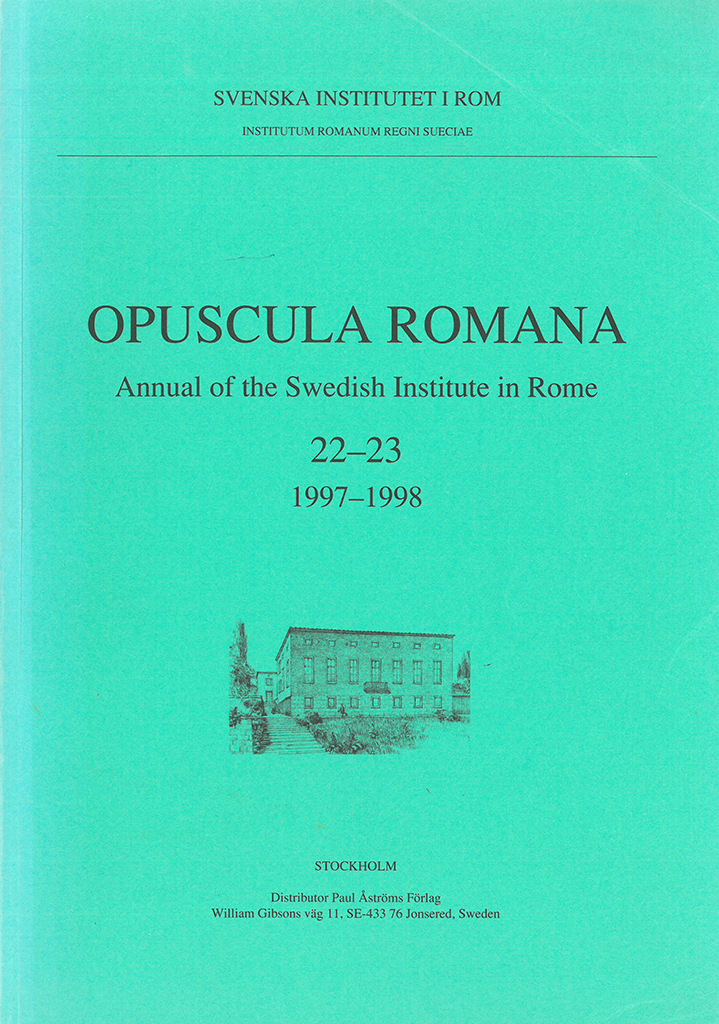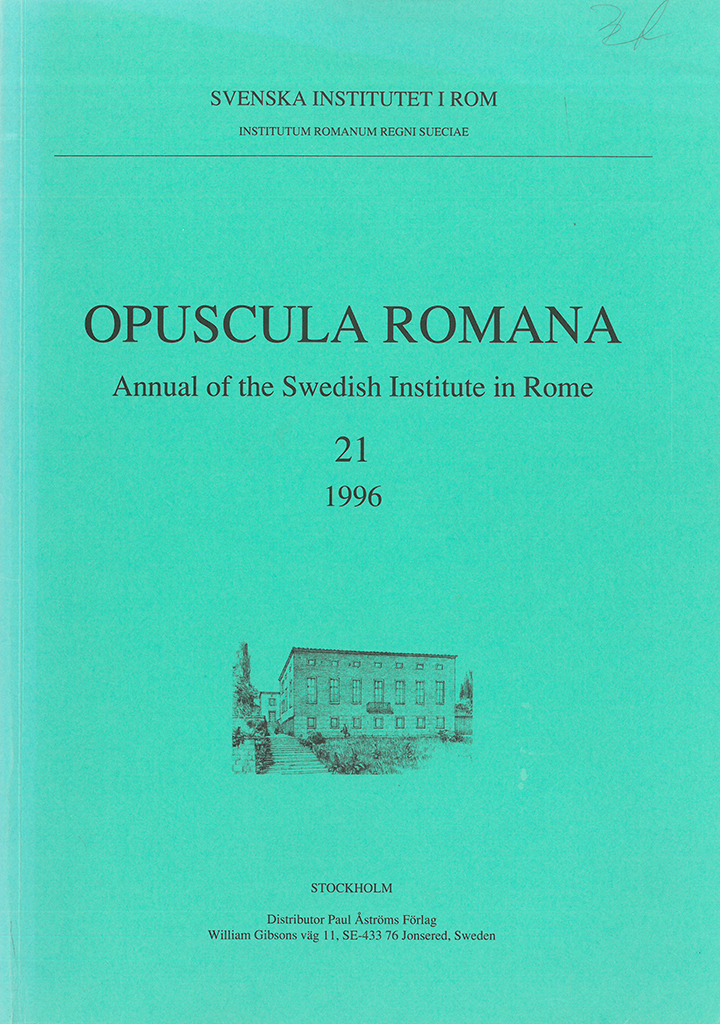Published by the Swedish Institute of Classical Studies in Rome. Distributed by Eddy.se AB. Via Tiburtina. Space, movement and artefacts in the urban landscape Edited by Hans Bjur & Barbro Santillo Frizell Abstract How can cities integrate historic layers into their urban development? How can tangible and intangible heritages be read, interpreted and utilised in a sustainable city and landscape development? What significance could an ancient road have in this context? These are the overall questions in this book. It contains a number of different approaches to the interaction between the ancient road Via Tiburtina and the surrounding urban landscape east of Rome towards Tivoli, a rich palimpsest of distinguishable interrelated layers created over at least three millennia. One hypothesis being explored is that structures like Via Tiburtina still can determine the morphology of the urban landscape. Settlements, buildings, space, movement and cultural artefacts have therefore come into focus in investigating whether broken connections could be re-established, and thus creating a dialogue between Rome’s earlier epochs and the future. Contents Index map Introduction Hans Bjur & Barbro Santillo Frizell | Ways to urban landscape archaeology Hans Bjur | That’s the way it is Movement Barbro Santillo Frizell | Changing pastures…
Published by the Swedish Institute of Classical Studies in Rome. Distributed by Eddy.se AB. Opuscula Romana. Annual of the Swedish Institute in Rome 31–32, 2006–2007 Contents Johnny R. Bengtsson | Late Bronze Age handles from the Apennine settlement at Luni sul Mignone: Some chronological observations Ingela M.B. Wiman & Yvonne Backe-Forsberg | Surfacing deities in later Etruscan art and the sacellum at San Giovenale Allan Klynne | The Villa Selvasecca revisited John W. Hayes | Villa Selvasecca: the pottery finds Ebba Engström & Ragnar Hedlund | Villa Selvasecca: the coins Dominic Ingemark | Villa Selvasecca: the glass Anne-Marie Leander Touati | Interim report of the Swedish Pompeii Project: Work 2000–2004/5 in Insula V 1. Introduction Margareta Staub Gierow | The House of the Greek Epigrams V 1,18.11–12: preliminary report 2000–2004 Arja Karivieri & Renée Forsell | The House of Caecilius Iucundus, V 1,22–27: a preliminary report Henrik Boman & Monica Nilsson | The commercial establishments V 1,13; V 1, 14–16; V 1,20–21: preliminary report 2001–2004 Mark Robinson | Evidence for garden cultivation and the use of bedding-out plants in the peristyle garden of the House of the Greek Epigrams (V 1, 18i) at Pompeii Henrik Boman & Monica Nilsson |…
Published by the Swedish Institute of Classical Studies in Rome. Distributed by Astrom Editions. Opuscula Romana. Annual of the Swedish Institute in Rome 25–26 Contents Suzanne Dixon | How do you count them if they’re not there? New perspectives on Roman cloth production (pp. 7–17) Dominic Ingemark | Literacy in Roman Britain: the epigraphical evidence (pp. 19–30) Viktoria Laeben-Rosén | The importance of patricians as symbolic carriers of tradition in late-Antonine and Severan society (pp 31–44) Peter Liljenstolpe | Rustication and decor in Roman architecture: their reflection in the architecture of the 16th century with special attention to their use in the classical orders (pp. 45–72) Eva Minten | Roman children and their pets: a socio-iconographical survey (pp. 73–77) Mia-Maria Salomonsson | Roman legates in the Republic (pp. 79–88) Martin Söderlind | Romanization and the use of votive offerings in the eastern Ager Vulcentis (pp. 89–102) Örjan Wikander | Senators and equites VIII. The cognomina of new men in the Late Republic (pp. 103–108) Ingela M.B. Wiman & Sten Ekman | Man and nature in Etruria: natural resources management in the Massetano area (Tuscany, Italy) (pp. 109–124) Book reviews Ingela M.B. Wiman | L. Bonfante, Corpus Speculorum Etruscorum: USA 3….
Published by the Swedish Institute of Classical Studies in Rome. Distributed by Astrom Editions. Opuscula Romana. Annual of the Swedish Institute in Rome 22–23, 1997–1998 Contents Olof Brandt, ‘Il battistero lateranense da Constantino a Ilaro. Un riesame degli scavi’, pp. 7–65 Daniel Fuglesang, ‘Two unpublished chamber tombs from San Giovenale’, pp. 67–89 Peter Liljenstolpe, ‘The Roman Blattkelch capital. Typology, origin and aspects of employment’, pp. 91–126 Peter Liljenstolpe & Allan Klynne, ‘The imperial gardens of the Villa of Livia at Prima Porta. A preliminary report on the 1997 campaign’, pp. 127–147 Manlio Lilli, ‘Un ambiente termale lungo la via Calmazzo—Urvinum Mataurense, presso il vicus di Canavaccio (PS)’, pp. 149–155 ‘The Swedish Institute in Rome. Report for the academic years 1996–1997 and 1997–1998’, pp. 157–160 Bibliographical information Opuscula Romana. Annual of the Swedish Institute in Rome 22–23, Stockholm 1998. ISSN 0471-7309. Softcover, 160 pages.
Published by the Swedish Institute of Classical Studies in Rome. Distributed by Astrom Editions. Opuscula Romana. Annual of the Swedish Institute in Rome 21, 1996 Contents Gabriella Barbieri, Le necropolis etrusco-romane di Poggio Giudio e Casale Merlani presso Viterbo (pp. 7–51) Peter Danner, Bikonische Gefässe aus Chiusi (pp. 53–56) Barbro Santillo Frizell, Per Itinera Callium. Report on a pilot project (pp. 57–81) Lars Karlsson, The altar of Hieron at Syracuse. A discussion of its function (pp. 83–87) Allan Klynne & Peter Liljenstolpe, The Villa of Livia at Prima Porta. A report on the excavation of room 45 (pp. 89–100) Peter Liljenstolpe, An Ionic capital from the Villa of Livia at Prima Porta (pp. 101–105) Margareta Strandberg Olofsson, Celebration or death? Aspects of a new amphora from the Micali Painter’s workshop and the iconography of Etruscan black-figured vases (pp. 107–118) Örjan Wikander, Senators and equites VII. Matrilinear relationships and cognate nomenclature in the Roman Republic (pp. 119–124) Book reviews Allan Klynne, review of T.J. Cornell, The beginnings of Rome. Italy and Rome from the Bronze Age to the Punic Wars (c. 1000–264 BC) (pp. 125–129) Örjan Wikander, review of S.B. Downey, Architectural terracottas from the Regia (pp. 129–131) Örjan Wikander, review…





